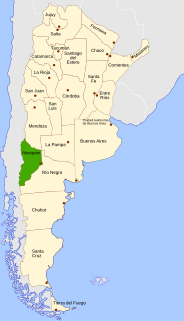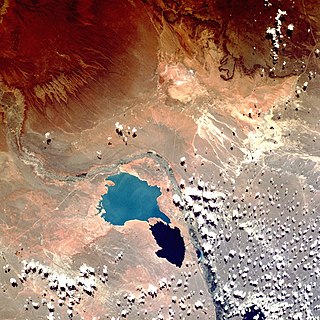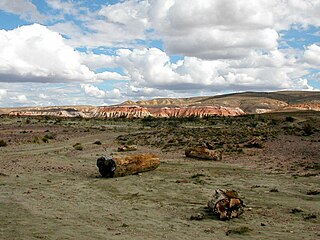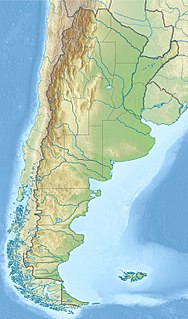| Chico River (Lower Chubut) | |
|---|---|
Map of the Chubut drainage basin. Chico River is shown by the dotted line (lower right). | |
| Country | Argentina |
The Chico River is a river of Chubut Province, Argentina. It is about 300 kilometres (190 mi) long, flowing in a northeasterly direction from the vicinity of Lake Colhue Huapi. It is a tributary of the Chubut River, joining it at the Florentino Ameghino Dam.

Chubut is a province in southern Argentina, situated between the 42nd parallel south, the 46th parallel south, the Andes range to the west, and the Atlantic ocean to the east. The province's name derives from the Tehuelche word chupat, meaning "transparent," their description of the Chubut River.

Argentina, officially named the Argentine Republic, is a country located mostly in the southern half of South America. Sharing the bulk of the Southern Cone with Chile to the west, the country is also bordered by Bolivia and Paraguay to the north, Brazil to the northeast, Uruguay and the South Atlantic Ocean to the east, and the Drake Passage to the south. With a mainland area of 2,780,400 km2 (1,073,500 sq mi), Argentina is the eighth-largest country in the world, the fourth largest in the Americas, and the largest Spanish-speaking nation. The sovereign state is subdivided into twenty-three provinces and one autonomous city, Buenos Aires, which is the federal capital of the nation as decided by Congress. The provinces and the capital have their own constitutions, but exist under a federal system. Argentina claims sovereignty over part of Antarctica, the Falkland Islands, and South Georgia and the South Sandwich Islands.
Before 1939 water from the Senguerr River entered the Chico via an outlet on the east side of Lake Colhue Huapi, but heavy use of water for irrigation has lowered the lake level and led to desiccation of the Chico river. The wide valley of the Chico is mostly dry today, except during periods of especially heavy snowmelt in the Andean headwaters of the Senguerr.

The Senguerr River is a river of the Argentine province of Chubut. It begins its journey from the system of glacial lakes La Plata and Fontana in the Andes Mountains.

Irrigation is the application of controlled amounts of water to plants at needed intervals. Irrigation helps to grow agricultural crops, maintain landscapes, and revegetate disturbed soils in dry areas and during periods of less than average rainfall. Irrigation also has other uses in crop production, including frost protection, suppressing weed growth in grain fields and preventing soil consolidation. In contrast, agriculture that relies only on direct rainfall is referred to as rain-fed or dry land farming.

The Andes or Andean Mountains are the longest continental mountain range in the world, forming a continuous highland along the western edge of South America. This range is about 7,000 km (4,300 mi) long, about 200 to 700 km wide, and of an average height of about 4,000 m (13,000 ft). The Andes extend from north to south through seven South American countries: Venezuela, Colombia, Ecuador, Peru, Bolivia, Chile and Argentina.










